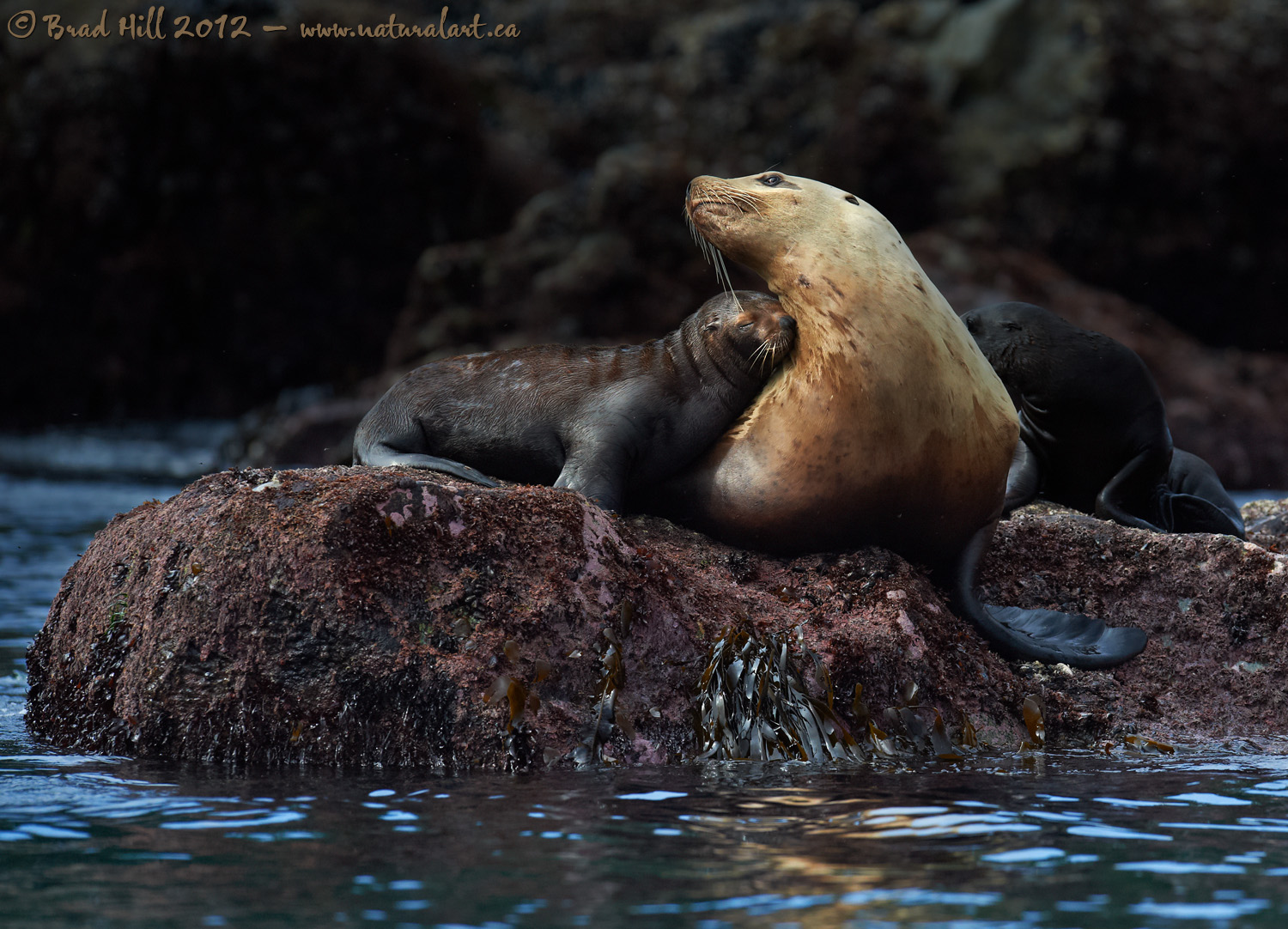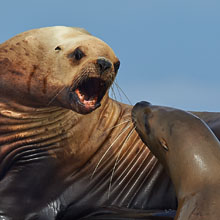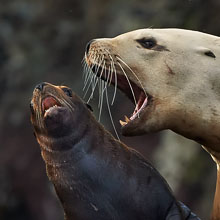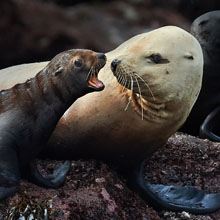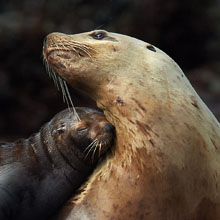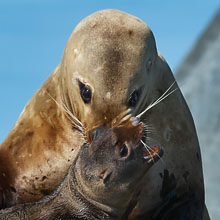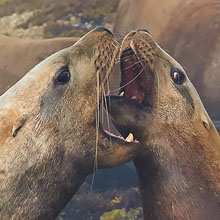Availability: Undetermined - Enquiries?
In the Field
A Cuddle Amongst Chaos. Northern Vancouver Island, BC, Canada. August 20, 2012.
It should be fairly obvious to anyone who has spent time traveling through the various galleries on this website that bears rate real high on my "favourite subjects" list. But over the last couple of summers I've found another species that I absolutely love to photograph - Steller Sea Lions. These highly specialized aquatic mammals have a Jekyll-Hyde thing going on when it comes to their mobility - awkward (but not slow moving) on land, they are absolutely graceful and stunningly beautiful to watch when they take to water. And, if you're fortunate enough to find a "photographable" colony the range of social behaviours and interaction types you're presented with is mind-boggling.
I captured this very brief moment of affection between a female sea lion and its pup while they were surrounded by bedlam and chaos - the rocks all around this one had sea lions on them that were jousting for position and crawling all over one another. The deafening roar of bellowing lions was overwhelming, but apparently mom and pup saw a brief moment where they could "steal" an affectionate moment and they took good advantage of it. This is the third image in a sequence of shots showing an intense interaction between a female Steller's Sea Lion and its pup. Seconds before this shot the pup was bawling in mom's face (while showing its needle-sharp teeth) and seconds after I shot it mom dove into the water. But for a brief moment there was...peace and harmony.
Photographing sea lions in a natural setting is challenging. The colonies are often in remote locations and best accessed from the water (which almost always seems to be rough!). The range of behaviours you can witness is diverse, but most interactions are only fleeting and can be lost (or simply missed) because of the how darned much action is going on all around you. Isolating and capturing compelling visual "snippets" can be challenging and often means you have to use a moderate to long telephoto lens - and odds are you're using it hand-held from a small boat that's bobbing like a cork! Uber-challenging - but among some of the most "fun" shooting I've ever done...kind of like mixing riding a bucking bronco with threading a needle!
Here's a higher resolution (2400 pixel) version of mom and pup making up:
• A Cuddle Amongst Chaos: Download 2400 pixel image (JPEG: 2.0 MB)
ADDITIONAL NOTES:
1. This image - in all resolutions - is protected by copyright. I'm fine with personal uses of it (including use as desktop backgrounds or screensavers on your own computer), but unauthorized commercial use of the image is prohibited by law. Thanks in advance for respecting my copyright!
2. Like all wildlife photographs on this website, this image was captured following the strict ethical guidelines described in The Wildlife FIRST! Principles of Photographer Conduct. I encourage all wildlife photographers to always put the welfare of their subjects above the value of their photographs.
3. This image was captured during my "Humpback, Orcas, Sea Lions & More" photo tour in August of 2012. Each year I offer trips into two different parts of the Great Bear Rainforest as well as one to photograph aquatic mammals and oceanscapes near the northern tip of Vancouver Island. And, in selected years, I also offer photo tours to locations to capture other highly sought-after subjects, such as various owl species of the boreal forest and wildlife of Canada's Arctic. Details about these trips can be found on the Photo Tours page of this website.
Behind the Camera
A Cuddle Amongst Chaos. Northern Vancouver Island, BC, Canada. August 20, 2012.
Digital Capture; RAW 14-bit format; ISO 1400.
Nikon D4 paired with Nikkor 400mm f2.8G VR lens. Hand-held from floating Zodiac inflatable boat. VR on and set to "normal" mode.
1/1600s @ f5.6; -1.0 stop compensation from matrix-metered exposure setting.
At the Computer
A Cuddle Amongst Chaos. Northern Vancouver Island, BC, Canada. August 20, 2012.
RAW Conversion to 16-bit TIFF, including first-pass/capture sharpening using Capture One Pro. Three raw variants (processed from raw) differing by a total of 1.0 stops in exposure.
Further digital corrections on resulting 16-bit TIFF files using Adobe's Photoshop CS6 and Light Craft's Lightzone. Photoshop adjustments including compositing the raw conversion variants (layering and masking), selective colour saturation and desaturation, selective tweaks to exposure, selective application of warming filter (all using adjustment layers) and selective sharpening for web output. Final tone tweaking performed using tonemapper/re-light tool in Lightzone.
Conservation
A Cuddle Amongst Chaos. Northern Vancouver Island, BC, Canada. August 20, 2012.
Ten percent of the revenue generated by this image will be donated to Raincoast*.
Species Status in Canada**: Special Concern (April 2007) - protected off the North American coast since 1911.
Back in the late 1800's and early 1900's the Sea Otter (Enhydra lutris) was hunted to near extinction along both the Asian and North American Pacific Coasts. The reason? It's luxuriant coat. Otters are unlike any other aquatic mammal in that they don't use fat or blubber to insulate themselves from the chilling effects of the water they are found in. Instead, they rely on their amazingly thick fur coat for insulation. Their amazing coats have a higher density of hair (up to 150,000 strands of hair per square cm!) than any other animal in existence today. To ensure that this coat serves its insulative purpose, otters spend a disproportionately large amount of time grooming their coat (to ensure its natural oils continue to provide an effective waterproof barrier). Unfortunately, the biological functioning of the otters coat can be easily fouled by contamination by oil and other hydrocarbons - thus making them extremely sensitive to the effective of marine oil spills.
Other fascinating aspects of the biology and behaviour of the sea otter include the use of tools (they will use rocks to break apart shellfish such as sea urchins), and the fact that they have an metabolic rate two to three times higher than other mammals of their size. This means they must eat 25% to 38% of their own body weight DAILY, just to to replace the calories burned through maintaining their body temperature in the cold water environment they live in.
*The Raincoast Conservation Society (and Foundation) is an effective and efficient organization that has been fighting for protection of this unique habitat. If you are looking for a meaningful way to contribute to the conservation of this amazing ecosystem, Raincoast will provide maximal "bang" for your conservation dollars.
**as determined by COSEWIC: The Committee on the Status of Endangered Wildlife in Canada












